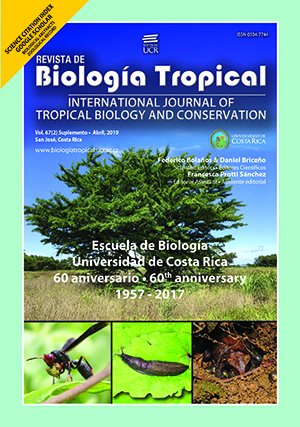Resumen
Los factores biomecánicos, el comportamiento e historia natural de las especies pueden influenciar la forma y dimensión del ala en las aves. Por lo tanto, la morfología de las alas de cada especie podría estar adaptada al ambiente en el que habitan. En palomas (familia Columbidae) existe un gradiente de especies que tienden a volar mucho y otras que vuelan muy poco. El objetivo de esta investigación es determinar si la forma de las alas de seis especies de palomas se asocia con su capacidad de vuelo. Predecimos que las especies Patagioenas flavirostris y P. nigrirostris que tienden a volar largas distancias presentan alas relativamente largas y puntiagudas; mientras que Geotrygon montana que se desplaza principalmente caminando presenta alas relativamente anchas y redondeadas. Especies con capacidad de vuelo intermedio (Leptotila verreauxi, L. cassini y Zenaida asiatica) van a presentar alas con características intermedias. Estimamos la carga alar, proporción de la forma, conicidad alar, largo relativo y el área alar promedio para cada especie. Realizamos un análisis discriminante para determinar cuál combinación de variables explica mejor la diferencia morfológica de las alas entre las seis especies y probamos que tan robusto es este modelo mediante una prueba binomial. El modelo clasificó correctamente el 57 % de los individuos en su propia especie. Por lo tanto, encontramos que el tipo de desplazamiento predominante en cada una de las seis especies de Columbidae analizadas, se asocia con la morfología alar: alas adaptadas para vuelos en zonas abiertas en P. flavirostris y P. nigrirostris, alas adaptadas para vuelos muy maniobrables en hábitats densos en G. montana, y alas con características intermedias en L. verreauxi, L. cassini y Z. asiatica.
Citas
Arizaga, J., Campos, F., & Alonso, D. (2006). Variation in wing morphology among subspecies might reflect different migration distances in Bluethroated. Ornis Fennica, 83, 162-169.
Baptista, L. F., Trail, P. W., & Horblit, H. M. (1997). Pigeons, Doves (Columbidae). In J. del Hoyo, A. Elliott, J. Sargatal, D. A. Christie, & E. de Juana (Eds.), Handbook of the Birds of the World Volume 4: Sandgrouse to Cuckoos (pp. 60-243). Barcelona, Spain: Lynx Edicions.
Corvidae, E. L., Bierregaard, R. O., & Peters, S. E. (2006). Comparison of wing morphology in three birds of prey: correlations with differences in flight behavior. Journal of Morphology, 267, 612-622. DOI: 10.1002/jmor.10425
Dial, K. P. (1992). Avian forelimb muscles and nonsteady flight: can birds fly without using the muscles in their wings?. Auk, 109, 874-885. DOI: 10.2307/4088162
Gibbs, D., Barnes, E., & Cox, J. (2001). Pigeons and Doves. A Guide to the Pigeons and Doves of the World. New Haven, Connecticut, USA: Yale University Press.
Hammer, Ø., Harper, D. A. T., & Ryan, P. D. (2001). PAST: Paleontological statistics software package for education and data analysis. Palaeontologia Electronica, 4(1),1-9. Recuperado de http://palaeo-electronica.org/2001_1/past/issue1_01.htm
Jetz, W., Thomas, G. H., Joy, J. B., Hartmann, K., & Mooers, A. O. (2012). The global diversity of birds in space and time. Nature, 491, 444-448. DOI: 10.1038/nature11631
Kirmse, W. (1998). Morphometric features characterizing flight properties of palearctic eagles. In R. D. Chancellor, B. U. Meyburg, & J. J. Ferrero (Eds.), Holarctic birds of prey (pp. 339-348). Berlin, Alemania: Proceedings of an international conference.
Lapiedra, O., Sol, D., Carranza, S., & Beaulieu, J. M. (2013). Behavioural changes and the adaptive diversification of pigeons and doves. Proceedings of the Royal Society of London B, 280, 20122893. DOI: 10.1098/rspb.2012.2893
Lockwood, R., Swaddle, J. P., & Rayner, J. M. (1998). Avian wingtip shape reconsidered: wingtip shape indices and morphological adaptations to migration. Journal of Avian Biology, 29, 273-292. DOI: 10.2307/3677110
Maddison, W. P., & Maddison, D. R. (2015). Mesquite: a modular system for evolutionary analysis (Version 3.04). Recuperado de http://mesquiteproject.org
Meade, A., & Pagel, M. (2014). BayesTraits (Version 2.0). Recuperado de http://www.evolution.rdg.ac.uk/BayesTraits.html
Norberg, U. M. (1981). Flight, morphology and the ecological niche in some birds and bats. Symposia of the Zoological Society of London, 48, 173-197.
Norberg, U. M. (1985). Flying, gliding, and soaring. In M. Hildebrand, D. M. Bramble, K. F. Liem, & D. B. Wake (Eds.), Functional vertebrate morphology (Pp. 129-158). Cambridge, Massachusetts, USA: Harvard University Press.
Norberg, U. M. (1995). How a long tail and changes in mass and wing shape affect the cost for flight in animals. Functional Ecology, 9, 48-54. DOI: 10.2307/2390089
Pennycuick, C. J. (2008). Modelling the flying bird (Vol. 5). USA: Elsevier.
Sandoval, L. (2009). Descripción del comportamiento de cuido parental en la codorniz de monte Colinus leucopogon. International Journal of Galliformes Conservation, 1, 36-40.
Savile, D. B. (1957). Adaptive evolution in the avian wing. Evolution, 11, 212-224.
Schneider, C. A., Rasband, W. S., & Eliceiri, K. W. (2012). NIH Image to ImageJ: 25 years of image analysis. Nature Methods, 9, 671-675. DOI: 10.1038/nmeth.2089
Schulenberg, T. S. (1983). Foraging behavior, eco-morphology, and systematics of some antshrikes. Wilson Bulletin, 95, 505-521.
Skutch, A. F. (1991). The life of the pigeon. Ithaca, New York, USA: Comstock Publishing.
Stiles, F. G., Altshuler, D. L., & Dudley, R. (2005). Wing morphology and flight behavior of some North American hummingbird species. Auk, 122, 872-886. DOI: 10.1642/0004-8038(2005)122[0872:WMAFBO]2.0.CO;2
Stiles, G. F., & Skutch, A. F. (1989). A guide to the birds of Costa Rica. Ithaca, New York, USA: Cornell University Press.
Videler, J. J. (2005). Avian flight. Oxford, UK: Oxford University Press.
##plugins.facebook.comentarios##

Esta obra está bajo una licencia internacional Creative Commons Atribución 4.0.
Derechos de autor 2019 Revista de Biología Tropical






